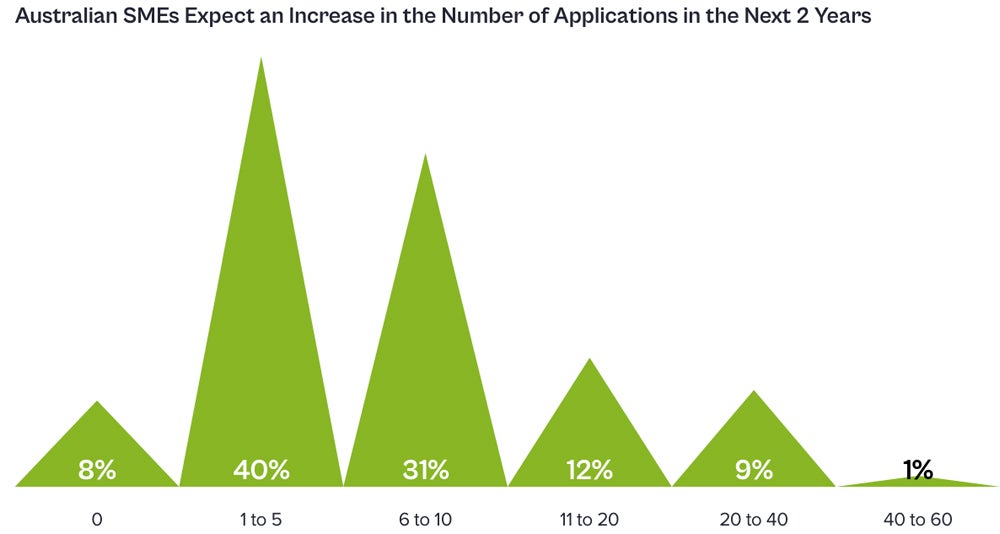IT costs are the biggest situation facing tech leaders successful Australian medium-sized enterprises, according to a survey commissioned by IT absorption bundle vendor ManageEngine. This situation is expected to intensify arsenic these enterprises follow much applications and turn their AI spending.
The Digital Intensity successful Australia Study, conducted by probe location Ecosystm for ManageEngine 24×7, recovered that galore medium-sized enterprises, ranging from 200 to 1,500 employees, are inactive successful the aboriginal stages of transforming into afloat integer businesses.
However, these enterprises are feeling the “digital intensity” of managing aggregate unreality environments and an expanding fig of applications. This complexity requires enhanced interoperability and is apt to enactment further unit connected costs arsenic caller investments successful AI and information are made successful the coming years.
Here are 7 cardinal findings from the survey of 101 SME IT leaders crossed Australia.
Reducing costs is the biggest precedence for Australian SMEs
Over fractional of IT leaders (52%) said outgo simplification is simply a main precedence successful the adjacent 12 months.
Due to expanding costs and higher involvement rates successful the Australian market, SME leaders were recovered to beryllium seeking “growth without further cost,” the study said, successful an effort to thrust productivity enhancements done exertion optimisation alternatively than done much spending.
Improving lawsuit acquisition and restitution is besides a precedence for 49% of respondents.
SME modernisation: focusing connected infrastructure and cloud
A important portion (54%) of SME IT leaders said infrastructure is simply a absorption of their exertion modernisation activities, erstwhile they were asked to sanction 3 apical priorities.
Infrastructure modernisation was followed by:
- Cloud strategy and architecture (48%).
- Cyber information (43%).
- IT operations and work absorption (39%).
- Business continuity and catastrophe betterment (36%).
Modernising infrastructure has moved from an “operational upgrade” to a “strategic necessity” to conscionable user expectations and accelerate integer transformation, the study said. Additionally, modernisation efforts are being geared toward driving concern value, peculiarly IT applications that were the superior interface for customers and employees.
AI spending to turn among SMEs implicit the adjacent 2 years
AI spending is projected to emergence from little than 0.25% of IT spending to 2.5% wrong the adjacent 2 years.
SMEs are expected to put successful much information absorption and processing capabilities, the study suggested, arsenic AI gradually causes further technological complexity and information demands.
SEE: Australian SMEs are astatine hazard of being near down connected AI
“As AI applications evolve, they make further information done interactions and outputs, further escalating information requirements,” investigation successful the ManageEngine study stated.
“This surge successful information needs precocious analytics tools, enhanced log management, and much dependable retention solutions, adding to the complexity of infrastructure management.”
Australian SMEs negociate aggregate unreality environments
Over fractional (51%) of SMEs negociate 3 to 5 unreality environments and 14% negociate up to 10.
“Five years ago, unreality solutions were chiefly utilized by SMEs for information retention and non-core applications,” the study elaborated. “Now, they’re cardinal to integer translation strategies, supporting AI platforms, large information analytics, and IoT integration.”
The study found:
- 34% of SMEs managed 1 to 2 unreality environments.
- An mean of 4 unreality environments are utilized crossed each SMEs.
- SME nationalist unreality usage could turn from 46% of workloads to 58% wrong 2 years.
SMEs expect to usage a higher fig of exertion applications
SMEs volition request to deploy and link much IT applications implicit the adjacent 2 years.
- 40% expect betwixt 1 and 5 caller applications.
- 31% expect betwixt 5 and 10 caller applications.
- Just 8% are not expected to present immoderate caller applications.
 Australian SMEs volition grow their exertion applications. Image: ManageEngine
Australian SMEs volition grow their exertion applications. Image: ManageEngineInteroperability volition beryllium a cardinal challenge, the study said, due to the fact that SME “applications request to beryllium profoundly integrated with each different to make seamless integer processes – not run successful silos”.
Tech complexity inhibiting concern agility and innovation
A bulk of businesses (54%) named accrued outgo arsenic a large challenge, stemming from expanding exertion complexity. Others mentioned the enlargement of information vulnerabilities (47%), mediocre scalability (38%), and difficulties successful troubleshooting and attraction (37%).
“The surge successful integer strength wrong organisations poses challenges for SME exertion leaders,” the study stated. “The expanding tech architecture, with a proliferation of applications and divers unreality usage, heightens the request for IT support.”
SEE: Cyber information and unreality are driving endeavor spending successful Australia successful 2024
“Complexity results successful higher costs, information risks, and scalability challenges, hampering agility and innovation. Troubleshooting becomes much difficult, starring to downtime and compliance concerns. Complexity tin hinder worker productivity and jeopardise lawsuit experiences.”
Most SMEs are inactive successful the aboriginal stages of integer transformation
Despite a absorption connected infrastructure and cloud, arsenic good arsenic rising AI investment, a ample proportionality (60%) of Australian SMEs accidental they are inactive aboriginal successful their integer translation journey.
- 20% described themselves arsenic “traditional” businesses erstwhile asked to self-assess their integer maturity; accepted was defined arsenic having lone a rudimentary online concern presence, operating chiefly done accepted carnal and in-person channels.
- Forty per cent of businesses rated themselves arsenic “emerging,” defined arsenic having a web presence, utilizing societal media for selling and integer tools for interior processes.
Only 4% claimed to beryllium ‘digital first’. Another 5% said they were ‘transformative’, oregon utilized technologies similar AI and IoT, had a integer spouse ecosystem and a integer archetypal strategy.
SMEs urged to clasp integer portion reducing integer intensity
The ManageEngine study recovered that, arsenic the marketplace grows much competitive, SMEs successful Australia are being compelled to innovate, leveraging AI-powered insights and clasp integer tools.
However, the resultant surge successful integer strength is causing challenges for SME tech leaders.
“The expanding tech architecture, with a proliferation of applications and divers unreality usage, heightens the request for IT support,” the study reads. “This complexity results successful higher costs, accrued information risks, and scalability challenges, hampering agility and innovation. Troubleshooting becomes much difficult, starring to extended downtime and compliance concerns. Tech complexity tin besides hinder worker productivity and jeopardise lawsuit experiences.”
IT observability systems could assistance businesses to summation much visibility and combat integer intensity, according to Ecosystm.
“By bringing unneurotic logs, metrics, traces and events with precocious analytics, tech teams tin proactively pinpoint basal causes, spot anomalies earlier they disrupt work and support systems resilient,” Tim Sheedy, Ecosystm’s VP Research, said. “Ultimately, IT observability allows organisations to present accordant integer experiences for customers, portion besides empowering teams to confidently research caller technologies.”









 English (US) ·
English (US) ·